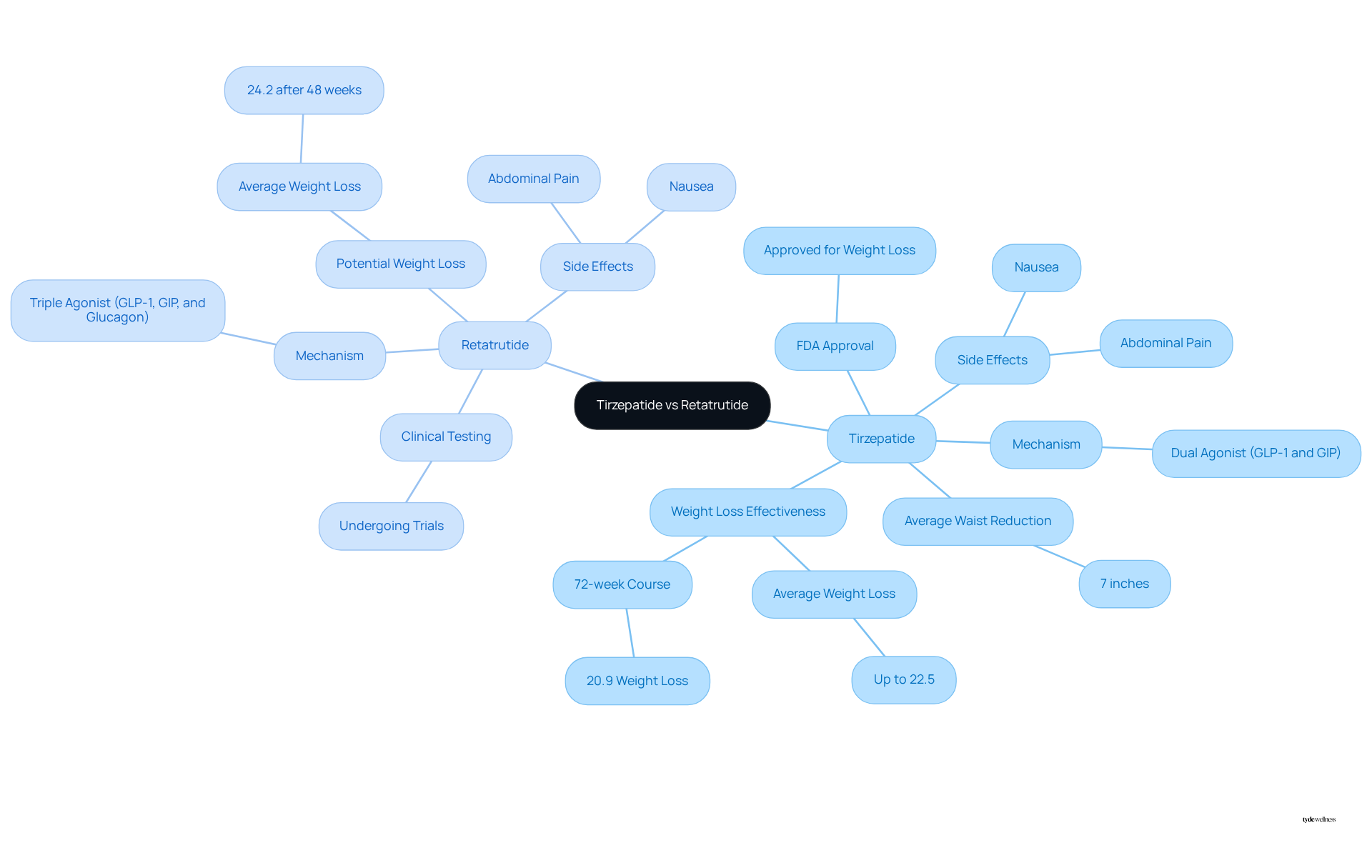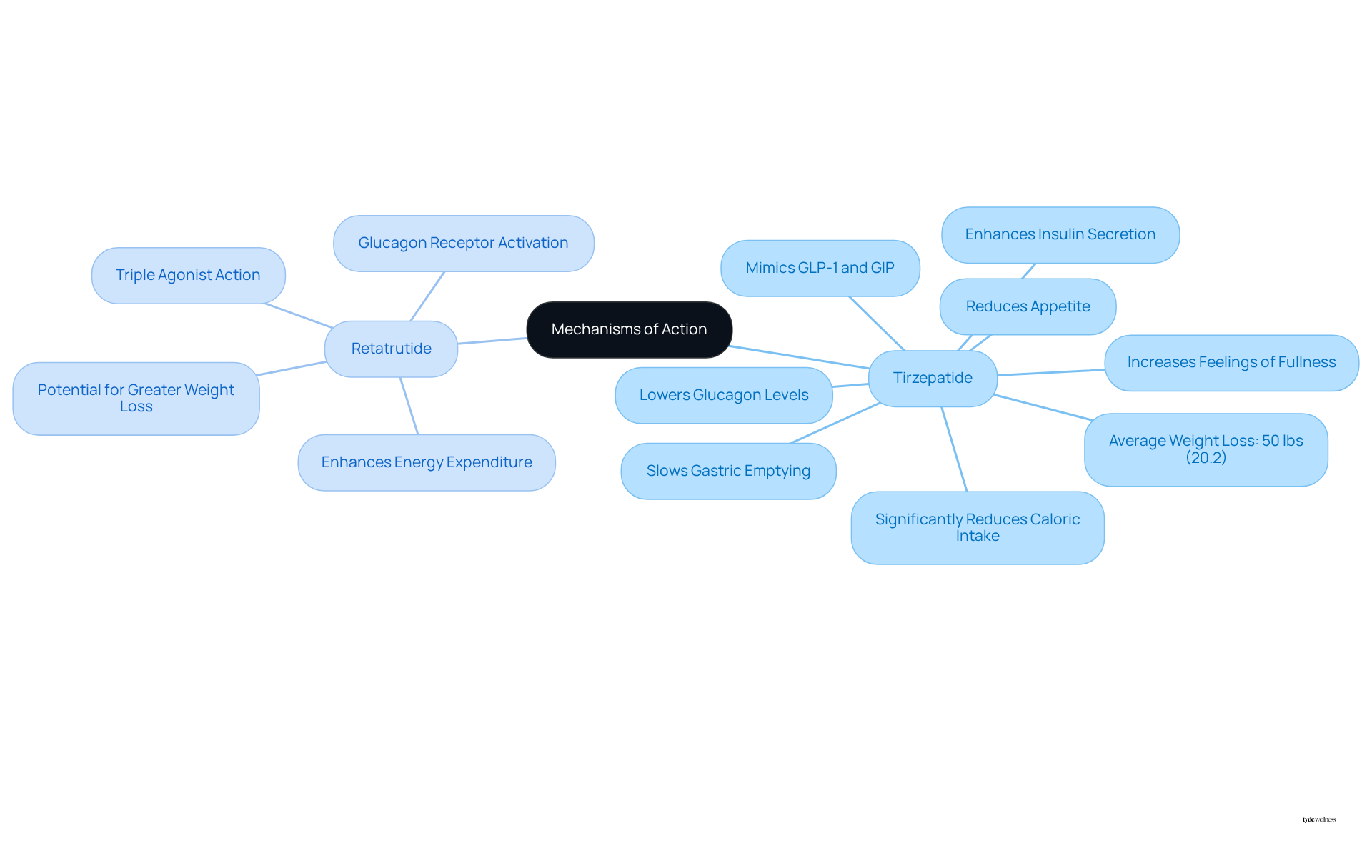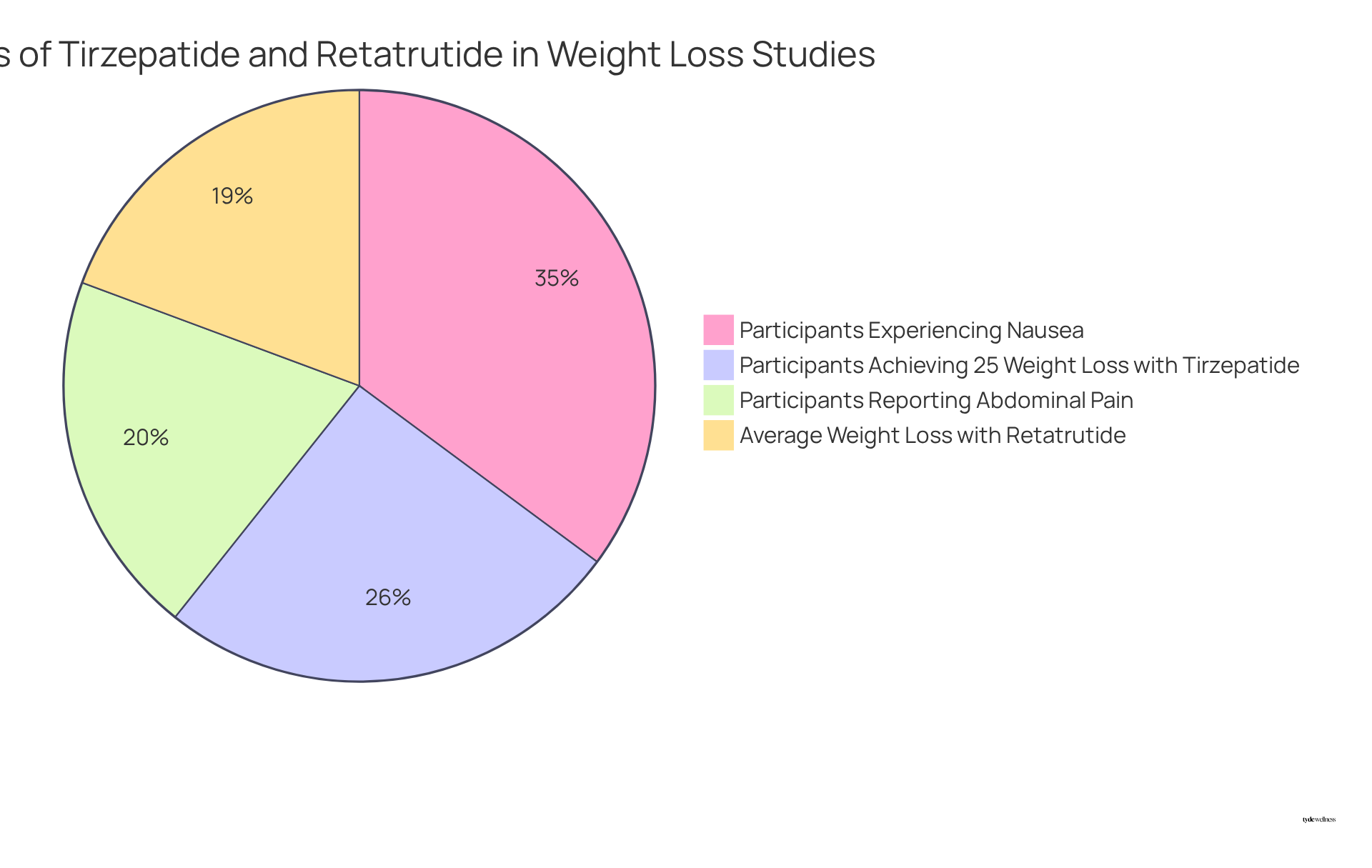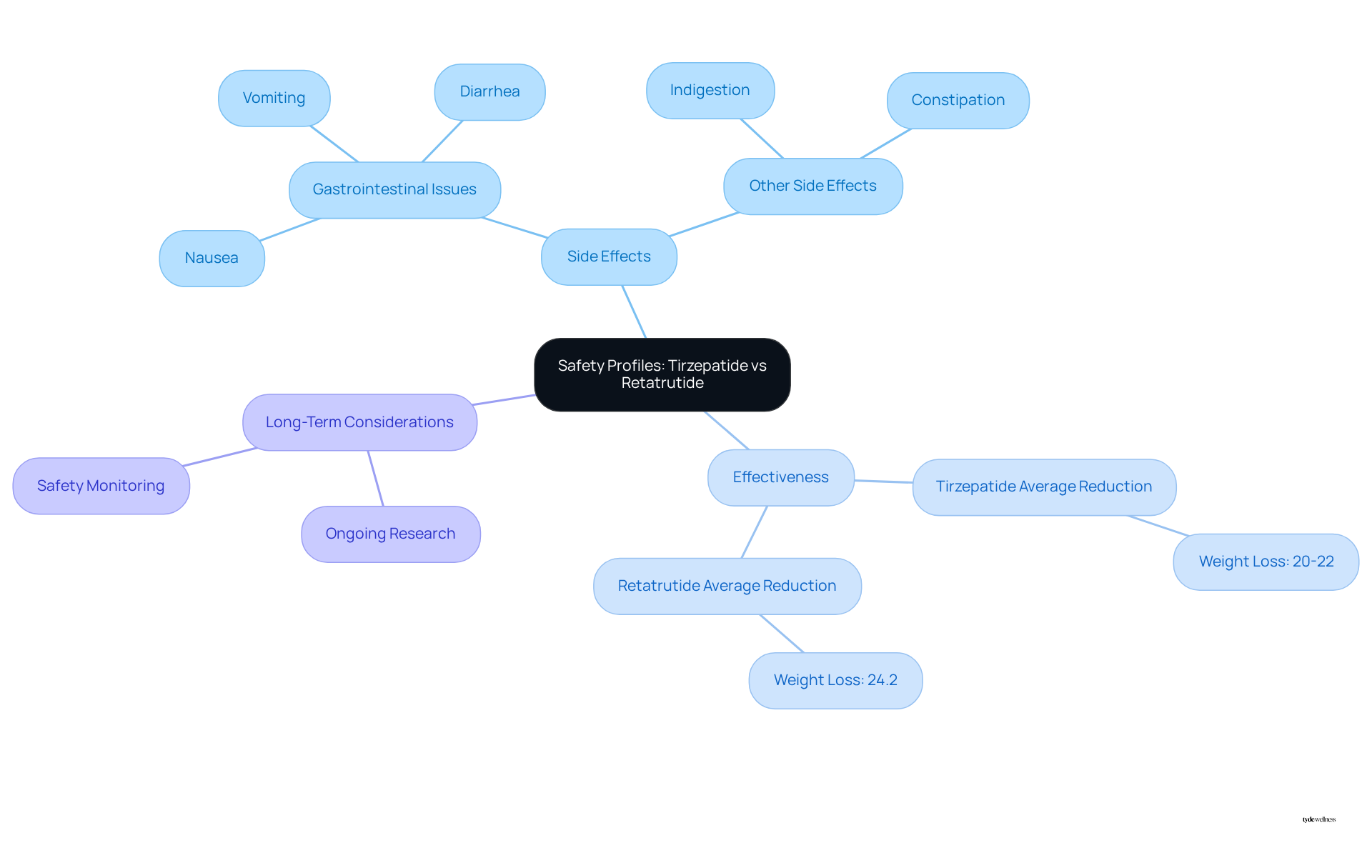Overview
This article compares the weight loss efficacy and safety of tirzepatide and retatrutide. Tirzepatide has established effectiveness, achieving up to 22.5% body mass reduction. In contrast, early studies indicate that retatrutide shows even greater potential, with an average reduction of 24.2%. This comparison emphasizes the dual action of tirzepatide as a GLP-1 and GIP agonist, while retatrutide operates through a triple agonist mechanism. This distinction may enhance appetite control and energy expenditure. Notably, both medications carry similar side effects, including nausea.
Introduction
In the evolving landscape of weight loss medications, tirzepatide and retatrutide emerge as groundbreaking options, each promising significant reductions in body mass through innovative mechanisms of action. Tirzepatide, characterized by its dual agonist properties, has already gained FDA approval and demonstrated impressive efficacy. In contrast, retatrutide, a novel triple agonist currently in clinical trials, suggests even greater potential for fat loss. As individuals evaluate their options, a critical question arises: which medication offers the optimal balance of efficacy and safety for achieving lasting weight loss results?
Overview of Tirzepatide and Retatrutide
In the context of tirzepatide vs retatrutide, tirzepatide, marketed under the brand name Zepbound, is a dual agonist that targets both the glucagon-like peptide-1 (GLP-1) and glucose-dependent insulinotropic polypeptide (GIP) receptors. It has received FDA approval for weight loss and is recognized for its effectiveness in reducing body mass and improving metabolic health. Clinical studies have shown that participants experienced significant reductions in body mass, with some achieving decreases of up to 22.5%. Furthermore, users of tirzepatide reported an average waist size reduction of 7 inches, alongside improvements in blood pressure, blood sugar, and blood fat levels, further underscoring its effectiveness.
In contrast, when discussing tirzepatide vs retatrutide, it is notable that retatrutide is a novel triple agonist that activates GLP-1, GIP, and glucagon receptors. Although it is still undergoing clinical testing, early findings suggest that when comparing tirzepatide vs retatrutide, the latter may offer even greater fat loss potential than other medications, with some studies revealing an average reduction of 24.2% after 48 weeks. This medication aims to enhance metabolic function and appetite regulation, positioning it as a promising option for individuals struggling with obesity.
However, it is essential to acknowledge that participants in studies for both medications have reported side effects, including nausea and abdominal pain. These factors should be considered when evaluating treatment options. As Dr. Louis Aronne has noted, while these drugs demonstrate remarkable efficacy, there remains a need for ongoing advancements in weight-loss drug development to better meet the needs of all patients.

Mechanisms of Action: How Each Medication Works
Tirzepatide operates by mimicking the effects of two key hormones: GLP-1 and GIP. This dual action enhances insulin secretion, lowers glucagon levels, and slows gastric emptying, resulting in reduced appetite and increased feelings of fullness. Participants using tirzepatide have lost an average of 50 pounds, or 20.2% of their body mass, in clinical trials. These mechanisms not only aid in reducing body mass but also enhance glycemic control, making tirzepatide especially advantageous for individuals with obesity and type 2 diabetes.
In contrast, Retatrutide functions as a triple agonist, incorporating glucagon receptor activation alongside GLP-1 and GIP. This additional mechanism further controls appetite and enhances energy expenditure, potentially providing a more comprehensive approach for managing body mass. Initial results indicate that when comparing tirzepatide vs retatrutide, Retatrutide may lead to more substantial reductions in body mass, improving its efficacy in addressing obesity. However, it is important to note that both medications may have side effects, including nausea and abdominal pain, which should be considered when evaluating treatment options.
Given the focus of Tyde Wellness on empowering women, particularly those experiencing life transitions such as menopause, understanding these mechanisms is crucial. The hormonal interactions of these medications can play a significant role in addressing the unique challenges faced by perimenopausal women in managing their body composition.

Comparative Efficacy: Weight Loss Outcomes
In clinical studies, the effectiveness of tirzepatide vs retatrutide has been demonstrated to be substantial in reducing body mass. Research indicates that approximately 32% of participants achieved a decrease in body mass of at least 25%. The typical reduction in mass reported after 68 weeks is about 15% of body mass, underscoring its efficacy as a mass management solution. However, it is important to note that around 44% of participants experienced nausea, and 25% reported abdominal pain, which are critical considerations when evaluating its safety profile.
Conversely, initial studies comparing tirzepatide vs retatrutide have shown that retatrutide has demonstrated even more promising outcomes, with participants losing an average of 24.2% of their body mass after 48 weeks. This suggests that retatrutide may be a more effective option for individuals seeking significant weight loss. Additionally, retatrutide is currently undergoing a phase 3 clinical trial expected to conclude in December 2025, which could further validate its efficacy and safety.
The comparative effectiveness of these medications indicates that, while both tirzepatide vs retatrutide are beneficial, the dual mechanism of action of retatrutide—affecting appetite and fat cell metabolism—may provide an alternative approach to managing body mass. Retatrutide may yield enhanced results, particularly for those who have not achieved their desired outcomes with other treatments. Furthermore, it has the potential to transform metabolic medicine, with applications extending beyond weight loss.

Safety Profiles: Side Effects and Long-Term Considerations
Tirzepatide vs retatrutide shows that both exhibit comparable side effects, predominantly gastrointestinal issues such as nausea, vomiting, and diarrhea. Individuals using these medications frequently describe these symptoms as mild to moderate, particularly during the early treatment stage. Research suggests that these side effects are four times more likely to arise compared to other medications. Current studies indicate a manageable risk profile; however, long-term safety data is still being collected.
Initial studies comparing tirzepatide vs retatrutide indicate that retatrutide is associated with gastrointestinal discomfort and has shown a somewhat increased occurrence of these side effects. Nevertheless, its overall safety profile remains acceptable, with no severe adverse events reported thus far. Notably, when considering tirzepatide vs retatrutide, the latter has demonstrated an average reduction of 24.2% after 48 weeks, which serves as a compelling comparison to the outcomes of other treatments.
As retatrutide progresses through clinical trials, ongoing research will provide more thorough data on its long-term safety and effectiveness, which is crucial for potential users to contemplate in their journey towards achieving their desired physique. Furthermore, ongoing studies are exploring potential new applications for this medication, which could be relevant for those considering long-term treatment options.

Conclusion: Choosing Between Tirzepatide and Retatrutide
Choosing between tirzepatide vs retatrutide necessitates a careful evaluation of personal reduction objectives, tolerance for potential side effects, and the aspiration for long-term efficacy.
- Tirzepatide boasts a proven safety history and confirmed outcomes, making it an excellent choice for individuals seeking a dependable method to reduce body mass, often resulting in a decrease of up to 22.5% in clinical studies.
- In contrast, retatrutide, currently undergoing clinical studies, shows promise for enhanced effectiveness, potentially offering up to a 24.2% reduction in mass over 48 weeks. This positions it as an appealing option for those who have not met their goals with tirzepatide vs retatrutide or who desire a more assertive approach to managing their condition.
- Both medications may lead to side effects such as nausea, vomiting, and gastrointestinal upset, which should be discussed with a healthcare provider.
- It is essential to consult a healthcare provider to determine the most suitable medication based on individual health profiles and weight loss objectives.
- Additionally, individuals should factor in the initial consultation fee of $150 and a follow-up consult fee of $75 associated with Tyde Wellness.
Both medications, tirzepatide vs retatrutide, represent significant advancements in obesity treatment and offer valuable alternatives for those aiming to improve their health and well-being.

Conclusion
Choosing between tirzepatide and retatrutide necessitates a nuanced understanding of each medication’s unique benefits and potential drawbacks. Tirzepatide, with its established dual agonist profile, has demonstrated significant weight loss results and is supported by FDA approval, making it a reliable choice for individuals seeking effective body mass reduction. In contrast, retatrutide, currently in clinical trials, shows even more promise with its triple agonist mechanism, potentially offering enhanced efficacy for those pursuing greater weight loss results.
Key insights throughout the article highlight the effectiveness of both medications in reducing body mass. Tirzepatide achieves an average reduction of 22.5%, while retatrutide shows early indications of up to 24.2%. Both options present side effects, predominantly gastrointestinal issues, which necessitate careful consideration and discussion with healthcare providers. The ongoing research into retatrutide may further illuminate its long-term safety and effectiveness, making it a compelling option for individuals who have not met their weight loss goals with tirzepatide.
Ultimately, the decision to choose between tirzepatide and retatrutide should be guided by personal health profiles, weight loss objectives, and tolerance for side effects. As the landscape of weight loss medications continues to evolve, staying informed about the latest studies and developments will empower individuals to make educated choices that align with their health and wellness goals. Engaging with healthcare professionals can provide tailored insights, ensuring that the selected treatment option best meets individual needs and expectations.
Frequently Asked Questions
What is tirzepatide and what is its primary use?
Tirzepatide, marketed under the brand name Zepbound, is a dual agonist that targets the glucagon-like peptide-1 (GLP-1) and glucose-dependent insulinotropic polypeptide (GIP) receptors. It has received FDA approval for weight loss and is effective in reducing body mass and improving metabolic health.
How effective is tirzepatide for weight loss?
Clinical studies have shown that participants using tirzepatide experienced significant reductions in body mass, with some achieving decreases of up to 22.5%. Users also reported an average waist size reduction of 7 inches and improvements in blood pressure, blood sugar, and blood fat levels.
What is retatrutide and how does it differ from tirzepatide?
Retatrutide is a novel triple agonist that activates GLP-1, GIP, and glucagon receptors. While still undergoing clinical testing, early findings suggest it may offer greater fat loss potential than tirzepatide, with some studies revealing an average reduction of 24.2% after 48 weeks.
What mechanisms do tirzepatide and retatrutide use to aid weight loss?
Tirzepatide mimics the effects of GLP-1 and GIP, enhancing insulin secretion, lowering glucagon levels, and slowing gastric emptying, which reduces appetite and increases feelings of fullness. Retatrutide, as a triple agonist, adds glucagon receptor activation, further controlling appetite and enhancing energy expenditure.
What side effects are associated with tirzepatide and retatrutide?
Participants in studies for both tirzepatide and retatrutide have reported side effects, including nausea and abdominal pain. These factors should be considered when evaluating treatment options.
How might these medications be relevant for women experiencing life transitions?
Understanding the hormonal interactions of tirzepatide and retatrutide is crucial for addressing the unique challenges faced by perimenopausal women in managing their body composition, especially as Tyde Wellness focuses on empowering women during such transitions.
List of Sources
- Overview of Tirzepatide and Retatrutide
- Zepbound Outperforms Wegovy in Head-to-Head Weight Loss Study (https://usnews.com/news/health-news/articles/2025-05-12/zepbound-outperforms-wegovy-in-head-to-head-weight-loss-study)
- Head-to-Head Trial Compares Weight Loss Drugs (https://news.weill.cornell.edu/news/2025/05/head-to-head-trial-compares-weight-loss-drugs)
- Eli Lilly weight-loss drug shows extraordinary promise (https://axios.com/local/indianapolis/2023/06/28/eli-lilly-weight-loss-drug)
- Zepbound (tirzepatide) showed superior weight loss over Wegovy (semaglutide) in complete SURMOUNT-5 results published in The New England Journal of Medicine | Eli Lilly and Company (https://investor.lilly.com/news-releases/news-release-details/zepbound-tirzepatide-showed-superior-weight-loss-over-wegovy)
- Mechanisms of Action: How Each Medication Works
- Tirzepatide Tops Semaglutide for Weight Loss: SURMOUNT-5 (https://tctmd.com/news/tirzepatide-tops-semaglutide-weight-loss-surmount-5)
- Study directly compares Zepbound and Wegovy for weight-loss results (https://foxnews.com/health/study-compares-zepbound-wegovy-weight-loss-direct-comparison)
- Pennington Biomedical Research Center Investigates Tirzepatide’s Role in Weight Loss and Metabolic Health (https://pbrc.edu/news/media/2025/tirzepatide.aspx)
- Head-to-Head Trial Compares Weight Loss Drugs (https://news.weill.cornell.edu/news/2025/05/head-to-head-trial-compares-weight-loss-drugs)
- Study reveals distinct mechanisms of action of tirzepatide and semaglutide (https://eurekalert.org/news-releases/1083711)
- Comparative Efficacy: Weight Loss Outcomes
- The weight-loss drugs being tested in 2025: will they beat Ozempic? (https://nature.com/articles/d41586-025-00376-w)
- Head-to-Head Trial Compares Weight Loss Drugs (https://news.weill.cornell.edu/news/2025/05/head-to-head-trial-compares-weight-loss-drugs)
- Experimental drug could offer more weight loss than any drug now on the market, study finds (https://nbcnews.com/health/health-news/experimental-drug-offer-weight-loss-drug-now-market-study-finds-rcna89702)
- Triple–Hormone-Receptor Agonist Retatrutide for Obesity — A Phase 2 Trial | NEJM (https://nejm.org/doi/full/10.1056/NEJMoa2301972)
- Retatrutide vs Tirzepatide: Which Is Better for Weight Loss? (https://revolutionhealth.org/blogs/news/retatrutide-vs-tirzepatide-for-weight-loss-and-metabolic-health)
- Safety Profiles: Side Effects and Long-Term Considerations
- Triple–Hormone-Receptor Agonist Retatrutide for Obesity — A Phase 2 Trial | NEJM (https://nejm.org/doi/full/10.1056/NEJMoa2301972)
- Real-world evidence highlights safety profile of tirzepatide in managing type 2 diabetes (https://news-medical.net/news/20240912/Real-world-evidence-highlights-safety-profile-of-tirzepatide-in-managing-type-2-diabetes.aspx)
- Efficacy and safety of retatrutide, a novel GLP-1, GIP, and glucagon receptor agonist for obesity treatment: a systematic review and meta-analysis of randomized controlled trials – PMC (https://pmc.ncbi.nlm.nih.gov/articles/PMC12026077)
- Retatrutide vs Tirzepatide: Which Is Right for You? | Nulevel Wellness Medspa (https://nulevelwellnessmedspa.com/retatrutide-vs-tirzepatide)
- Long-Term Safety of Tirzepatide: What Research and Experts Reveal (https://healthon.com/blogs/journal/is-tirzepatide-safe-for-long-term-use-expert-insights-and-research?srsltid=AfmBOopOOEpHKRhb4sQJQ5hJHi2yuXByeD8bG0zC-6SculVsYeFjiajm)
- Conclusion: Choosing Between Tirzepatide and Retatrutide
- Retatrutide vs Tirzepatide: Which Is Right for You? | Nulevel Wellness Medspa (https://nulevelwellnessmedspa.com/retatrutide-vs-tirzepatide)
- Retatrutide vs Tirzepatide: Which is Better for Weight Loss? – REFRESH MedSpa (https://refreshmed-spa.com/retatrutide-vs-tirzepatide-which-is-better-for-weight-loss)
- Breakingviews – Obesity drug boom has a new pecking order (https://reuters.com/breakingviews/obesity-drug-boom-has-new-pecking-order-2025-04-25)
- Retatrutide vs Tirzepatide: Which Is Better for Weight Loss? (https://revolutionhealth.org/blogs/news/retatrutide-vs-tirzepatide-for-weight-loss-and-metabolic-health)